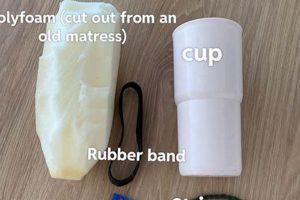A self-constructed platform designed to challenge stability and enhance balance skills is the focus. Typically, these projects involve a flat surface, such as a wooden board, placed atop a cylindrical object like a pipe or a specially shaped rocker. The resulting instability requires the user to actively engage core muscles and make constant adjustments to maintain equilibrium. Examples include a circular board on a half-roller or a rectangular platform balanced on a section of PVC pipe.
The construction of such a device offers advantages in terms of cost-effectiveness and customization. Pre-made balance tools can be expensive; therefore, creating a similar device offers a budget-friendly alternative. Furthermore, this approach allows individuals to tailor the dimensions and difficulty level to their specific needs and skill level. Historically, balance training has been incorporated into physical therapy and athletic training regimens, and these homemade options can make such training more accessible.
The following sections will delve into the materials required, construction methods, and safety considerations pertinent to building a functional and effective training tool. It will also explore various designs and modifications that can be implemented to increase the challenge and diversify the training experience.
Construction and Usage Guidelines
The following guidelines are provided to ensure a safe and effective experience when constructing and utilizing a balance platform created independently. These tips address material selection, construction techniques, and safety protocols.
Tip 1: Material Selection. Employ high-quality materials. For the platform, select a durable hardwood plywood or solid wood with sufficient thickness to support the intended user’s weight. The roller should be constructed from a dense, non-compressible material such as PVC pipe with a schedule rating appropriate for load bearing or a solid wood dowel. Avoid materials prone to splintering or cracking.
Tip 2: Secure Fastening. If the design incorporates multiple pieces, ensure all components are securely fastened using appropriate adhesives and mechanical fasteners, such as screws or bolts. Countersink fasteners to prevent protrusions that could cause injury. Allow adequate curing time for adhesives before use.
Tip 3: Surface Treatment. Apply a non-slip surface treatment to the platform. This may include applying grip tape, rubberized paint, or a textured coating. The chosen treatment should provide adequate traction in both dry and wet conditions to minimize the risk of slippage.
Tip 4: Roller Dimensions. The diameter and length of the roller directly influence the difficulty. A smaller diameter increases instability, while a longer length offers more lateral movement. Experiment with different dimensions to find a suitable balance between challenge and control.
Tip 5: Gradual Progression. Begin with short practice sessions and gradually increase the duration and intensity as balance improves. Use a stable surface, such as a wall or chair, for initial support. Focus on maintaining a neutral spine and engaging core muscles throughout the exercise.
Tip 6: Safety Precautions. Use the device in a clear, open area free from obstacles. Ensure the surrounding floor is level and provides adequate cushioning in case of a fall. Wearing appropriate footwear, such as athletic shoes with good traction, is recommended.
Tip 7: Routine Inspection. Regularly inspect the structure for signs of wear, damage, or loosening of fasteners. Address any issues promptly to prevent accidents. Replace worn or damaged components immediately.
Adhering to these guidelines enhances the longevity of the device and minimizes the risk of injury, promoting a safer and more productive training regimen. Safe and controlled usage will contribute to improved balance and coordination.
The following sections will provide information on advanced training techniques and modifications to further enhance the utility of this equipment.
1. Stability
Stability is a paramount concern in the design and utilization of a self-constructed balance platform. It dictates the ease or difficulty of maintaining equilibrium, influencing the device’s suitability for different skill levels and training objectives. The interplay between stability and the platform’s physical characteristics is critical for safe and effective use.
- Roller Geometry and Contact Area
The shape and surface area of the roller significantly impact stability. A larger diameter roller, or one with a flattened profile, inherently provides a broader base of support, thereby increasing stability. Conversely, a smaller, more cylindrical roller reduces the contact area, demanding greater user control and creating a more challenging experience. An example is the difference between a standard PVC pipe and a smaller diameter wooden dowel used as the roller; the latter would be significantly more unstable.
- Platform Dimensions and Weight Distribution
The size and weight distribution of the platform itself contribute to stability. A wider platform offers more room for foot placement and reduces the likelihood of tipping, while a heavier platform resists sudden movements and provides a more predictable response. Uneven weight distribution can introduce unintended instability, requiring careful consideration during the design and construction phases. For instance, a platform made from lightweight material, with a concentrated weight on one side, could prove difficult to control.
- Material Properties and Friction
The materials used in construction influence stability through their inherent properties. A non-slip surface on the platform enhances grip and prevents unwanted sliding, contributing to a more secure stance. Similarly, the friction between the roller and the floor affects the smoothness of movement. A roller with low friction may result in abrupt, uncontrolled shifts, while a high-friction roller may create excessive resistance, hindering fluid motion. Using rubber pads on the base of the roller is a real-world example of altering friction to increase stability.
- User Skill and Center of Gravity Control
Regardless of the platform’s design, the user’s ability to control their center of gravity is fundamental to maintaining stability. Proper technique, including core engagement and balanced weight distribution, is essential for mitigating instability and preventing falls. A skilled user can effectively manage a more unstable platform, while a novice may struggle even with a relatively stable one. Therefore, appropriate progression and skill development are vital aspects of balance training.
These interconnected factors highlight the complexity of stability in relation to balance platforms. Addressing these elements allows for the creation of a device that is both challenging and safe, enabling users to effectively improve their balance and coordination. Achieving the appropriate level of stability requires careful consideration of m
aterials, dimensions, and user skill, ensuring that the created equipment is neither too easy nor excessively dangerous.
2. Materials
The selection of materials for a self-constructed balance platform directly impacts its durability, performance, and safety. The choice of materials is not merely an aesthetic consideration; it represents a critical engineering decision that determines the device’s load-bearing capacity, stability, and overall longevity. For example, opting for softwood, such as pine, for the platform may result in premature wear or even structural failure under repeated use, whereas hardwood plywood or solid hardwood offers superior strength and resistance to deformation. The roller component similarly requires careful material selection; PVC pipe, while cost-effective, must be of sufficient schedule rating to withstand the user’s weight without collapsing. The materials are inextricably linked to the fundamental functionality.
The interplay between the platform material and the roller material further influences the platform’s dynamic behavior. A smooth platform surface paired with a high-friction roller material may create jerky, unpredictable movements, whereas a textured platform surface combined with a low-friction roller promotes smoother, more controlled motion. The choice of surface treatments, such as grip tape or non-slip coatings, also falls under the umbrella of material considerations. These treatments directly enhance traction, reducing the risk of slippage and improving user confidence. Consider the scenario where a user attempts to use a platform made of polished hardwood with a metal pipe as a roller; the lack of friction would render the platform exceptionally difficult and hazardous to use.
Ultimately, the success of a balance platform relies heavily on the informed selection and utilization of appropriate materials. Inadequate material selection can compromise the device’s structural integrity, leading to premature failure or even user injury. Conversely, thoughtful material choices can enhance the platform’s performance, durability, and safety, providing a valuable tool for balance training and rehabilitation. Therefore, understanding the mechanical properties and suitability of various materials is paramount for constructing a safe and effective training aid.
3. Dimensions
Dimensions are a critical determinant of a self-constructed balance platform’s difficulty and suitability for particular exercises or user skill levels. Understanding the relationship between various dimensional parameters and the resulting performance characteristics is essential for creating a safe and effective device.
- Platform Length and Width
The length and width of the platform dictate the available space for foot placement and influence stability. A longer platform allows for greater stance variation and can accommodate larger individuals, while a wider platform provides increased lateral stability, reducing the likelihood of tipping. Conversely, a shorter or narrower platform increases the challenge by limiting the base of support and requiring finer balance adjustments. A platform that is too short may not allow for comfortable foot placement, while one that is too narrow could lead to frequent loss of balance, particularly for novice users.
- Roller Diameter
The diameter of the roller is a primary factor in determining the overall instability. A smaller diameter roller creates a more pronounced instability due to the reduced contact area with the platform and the floor. This necessitates greater core engagement and finer motor control to maintain balance. A larger diameter roller provides a more stable base, making it suitable for beginners or individuals with limited balance skills. The selection of roller diameter should align with the user’s experience level and the intended training goals; a small diameter might be used by advanced users seeking a greater challenge.
- Platform Thickness
Platform thickness affects both durability and weight distribution. A thicker platform offers increased strength and resistance to bending, particularly when supporting heavier users. However, excessive thickness can also increase the overall weight of the platform, potentially making it less portable. The chosen thickness must strike a balance between structural integrity and usability. For example, a very thin platform may flex excessively, compromising stability and potentially leading to material failure.
- Roller Length
Roller length influences the range of motion and the type of balance challenges presented. A longer roller allows for greater lateral movement and requires the user to maintain balance across a wider range of angles. A shorter roller restricts lateral movement, focusing the challenge on fore-aft balance. The roller length should be chosen based on the desired training focus; a shorter roller may be preferred for exercises emphasizing core stability, while a longer roller may be used for exercises that require dynamic weight shifting.
The interplay of these dimensional parameters dictates the performance characteristics of the balance platform. Careful consideration of each dimension is essential for creating a device that is both safe and effective for the intended user and application. Modifying these dimensions can significantly alter the difficulty and training focus, allowing for a customized balance training experience.
4. Technique
Effective technique is intrinsically linked to the safe and beneficial use of a self-constructed balance platform. Improper technique negates potential benefits and significantly increases the risk of injury. The inherent instability of the device necessitates a deliberate and controlled approach, emphasizing core engagement, postural alignment, and precise weight distribution. For instance, leaning excessively in one direction to compensate for instability shifts the user’s center of gravity outside of the base of support, predisposing them to a fall. Conversely, consistent focus on a stable gaze point and deliberate muscular control fosters neuromuscular adaptation and reduces the likelihood of missteps. Thus, technique functions not simply as a method, but as a crucial component for safely harnessing the instability.
The application of proper technique extends beyond basic balance maintenance. Advanced movements, such as squats, lunges, or rotational exercises performed on the platform, require even greater precision and control. Executing these movements with incorrect form amplifies the instability and can lead to joint strain or muscle imbalances. For example, performing a squat with insufficient knee flexion or excessive forward lean places undue stress on the knee joint and compromises balance. However, employing a controlled descent, maintaining a neutral spine, and engaging the gluteal muscles facilitates a more stable and effective exercise. This controlled adaptation is key to promoting strength, stability, and coordination beyond simple static balancing.
In summary, technique serves as a critical regulator for effectively utilizing a balance platform. The inherent instability demands conscious effort to maintain postural control and execute movem
ents with precision. Mastery of proper technique mitigates the risk of injury, optimizes training outcomes, and unlocks the full potential of the device as a tool for enhancing balance, strength, and coordination. The effectiveness of a self-constructed platform is, therefore, dictated not only by its physical attributes but also by the user’s technical proficiency.
5. Safety
The construction and utilization of a self-made balance platform necessitates a rigorous adherence to safety protocols. The inherent instability of these devices introduces a potential for falls and injuries if precautions are not meticulously observed. The causal relationship between inadequate safety measures and adverse outcomes is direct: insufficient structural integrity, improper usage, or failure to account for environmental hazards significantly elevates the risk of accidents. Consequently, safety emerges not as an ancillary consideration but as a fundamental component of the entire endeavor, influencing material selection, construction techniques, and usage guidelines. For instance, a platform constructed with substandard materials may fail under load, resulting in a sudden loss of balance and subsequent injury. Similarly, using the platform on an uneven surface or without adequate clearance increases the probability of falls and collisions with surrounding objects.
Understanding the practical significance of these safety considerations translates into tangible benefits. Employing appropriate safety measures reduces the incidence of injuries, fostering a more positive and productive training experience. This may involve implementing non-slip surfaces on the platform to enhance traction, ensuring the roller is constructed from durable materials to prevent breakage, and using the device in a controlled environment free from obstructions. Moreover, users should commence with a gradual progression, mastering basic balance skills before attempting more advanced maneuvers. Such progressive training allows the body to adapt gradually, minimizing the strain on joints and muscles. The absence of such precautions may result in sprains, strains, fractures, or other injuries, hindering progress and potentially leading to long-term complications. Consider the impact of failing to inspect the device regularly for wear and tear: a cracked roller can lead to abrupt instability and falls.
In conclusion, safety is not merely a desirable attribute but a critical imperative in the context of self-constructed balance platforms. Challenges may arise from the need to balance cost-effectiveness with the pursuit of safety or from the inherent variability in construction skills and material availability. However, prioritizing safety through careful planning, meticulous execution, and responsible usage practices is paramount for realizing the benefits of balance training while mitigating the risks. The broader theme underscores the importance of responsible innovation and the need to couple creativity with a steadfast commitment to well-being.
6. Progression
The principle of progressive overload is crucial in balance training using a self-constructed platform. Beginning with an excessively unstable platform can lead to improper form, increased risk of injury, and discouragement. A graded approach, however, fosters gradual neuromuscular adaptations, enhancing balance and coordination effectively. Initiating training on a stable surface before transitioning to the platform, followed by the use of a larger diameter roller, represents a suitable starting point. Mastering static balance before introducing dynamic movements, such as squats or lunges, ensures a solid foundation. For example, an individual recovering from an ankle injury might begin by simply standing on a stable surface, then progress to a balance platform with a large diameter roller for static balancing, and finally advance to dynamic exercises on the same platform. The absence of such a progression can result in re-injury or the development of compensatory movement patterns.
Progressive modification of the platform itself provides another avenue for increasing challenge. This can involve reducing the roller diameter, increasing the platform length, or adding external weights to the platform. Furthermore, varying the surface characteristics, such as using a smoother surface to decrease friction, can increase difficulty. As an example, a user proficient with static balancing on a platform with a standard PVC roller could transition to a smaller diameter wooden roller to enhance the challenge. Simultaneously, exercises can be progressively overloaded by increasing the number of repetitions, sets, or the duration of each exercise. Incorporating visual distractions or unstable base surfaces off the platform, such as a foam pad, can also heighten the challenge.
The integration of progression is not without its challenges. It requires careful monitoring of user performance and adaptation, along with a willingness to adjust the training protocol as needed. Premature advancement can lead to setbacks, while insufficient challenge can hinder progress. Nevertheless, by implementing a well-structured and individualized progression plan, the self-constructed balance platform becomes a versatile and effective tool for enhancing balance, coordination, and overall functional fitness. This progressive approach underscores the importance of adapting the training stimulus to match the individual’s evolving capabilities, thereby maximizing training benefits and minimizing the risk of injury.
7. Customization
The practice of self-constructing a balance platform inherently permits significant customization, tailoring the device to meet specific training goals, physical limitations, or desired levels of challenge. Pre-manufactured balance tools often present a limited range of adjustability, whereas a do-it-yourself approach empowers the user to fine-tune various parameters to suit individual needs. This adaptability is a critical advantage, transforming a generalized piece of equipment into a personalized instrument for balance training and rehabilitation. The correlation is direct: increased customization yields a more effective and targeted training experience, while a lack of customization compromises the platform’s utility and relevance.
Customization manifests across several key dimensions. Platform size, roller diameter, surface texture, and even the inclusion of additional features such as resistance bands or handles can be modified to influence the difficulty and range of exercises. For instance, a physical therapist might construct a platform with a wider base and a larger diameter roller for a patient recovering from a stroke, gradually decreasing the stability as the patient regains balance and coordination. Conversely, an athlete seeking to enhance proprioception might opt for a narrower platform and a smaller diameter roller to maximize the challenge. The ability to adjust these parameters ensures that the balance platform remains effective as the user’s skills evolve. The construction may be further customized by utilizing different materials to obtain a desired look, or incorporating recycled elements to lessen environmental impact.
In conclusion, customization is not merely an optional add-on but an integral component of the self-constructed balance platf
orm paradigm. The ability to tailor the device to individual needs enhances its effectiveness, improves user safety, and fosters a more engaging and rewarding training experience. While challenges exist in determining the optimal configuration for each user, the potential benefits of a personalized approach far outweigh the complexities. This inherent capacity for modification positions the self-constructed balance platform as a versatile and adaptable tool for a wide range of individuals and applications.
Frequently Asked Questions
This section addresses common inquiries regarding the construction and utilization of a self-made balance platform. The information presented aims to provide clarity and guidance based on principles of physics, engineering, and exercise science.
Question 1: What are the primary safety concerns associated with the use of a DIY balance board?
Safety concerns center on structural integrity, user technique, and environmental factors. Structural failure of the platform or roller poses a direct risk. Inadequate user technique increases the probability of falls. Using the device on uneven surfaces or in cluttered environments also elevates the risk of injury.
Question 2: What type of materials are best suited for constructing a durable and effective balance platform?
Hardwood plywood or solid hardwood is recommended for the platform due to its strength and resistance to deformation. The roller should be constructed from a dense, non-compressible material, such as PVC pipe with an appropriate schedule rating or a solid wood dowel. Avoid materials prone to splintering or cracking.
Question 3: How does the roller diameter affect the difficulty of using a balance board?
A smaller diameter roller increases instability, demanding greater core engagement and finer motor control. A larger diameter roller provides a more stable base, making it suitable for beginners or individuals with limited balance skills. The selection of roller diameter directly impacts the challenge.
Question 4: Is it possible to overload the balance board with too much weight?
Yes. Exceeding the load-bearing capacity of the platform or roller can lead to structural failure and potential injury. The weight capacity is determined by the materials used and the platform’s design. Consult engineering guidelines for load calculations.
Question 5: Can a DIY balance board be used for physical rehabilitation?
Potentially, under the guidance of a qualified physical therapist. The balance platform can be a valuable tool for improving balance, coordination, and proprioception. However, its use should be integrated into a comprehensive rehabilitation program tailored to the individual’s specific needs and limitations.
Question 6: What is the recommended progression for learning to use a DIY balance board?
Begin with static balancing, gradually progressing to dynamic movements. Start with a stable surface before transitioning to the platform. Use a larger diameter roller initially and decrease the diameter as balance improves. Incorporate exercises that challenge balance in multiple planes of motion.
In summary, the successful and safe utilization of a self-made balance platform hinges on careful planning, appropriate material selection, and adherence to proper technique and progressive overload principles.
The subsequent section will provide a comprehensive guide to specific exercises that can be performed utilizing the device.
Conclusion
The preceding exploration of the diy balance board elucidates its potential as a versatile training tool. Structural integrity, progressive adaptation, and technical proficiency emerge as critical determinants of its safe and effective utilization. Material selection, dimensional parameters, and adherence to established safety protocols directly influence the platform’s performance and longevity. A customized approach, tailored to individual needs and skill levels, further enhances its utility and relevance within diverse training or rehabilitative contexts.
Future development should prioritize improved safety features and enhanced user education resources. The pursuit of innovative designs and construction techniques, coupled with rigorous testing and validation, will contribute to the ongoing evolution of this accessible and adaptable fitness modality. Continued investigation into the biomechanical effects and clinical applications of the diy balance board remains essential for maximizing its potential benefits while mitigating inherent risks.







